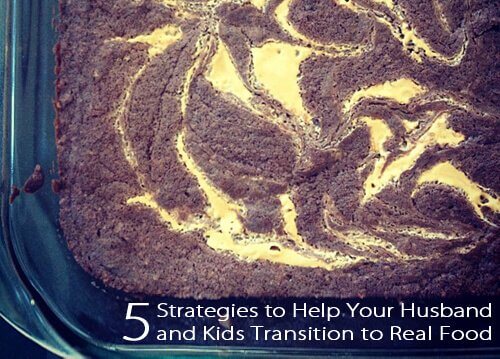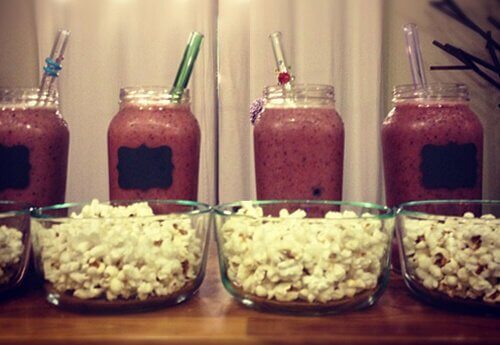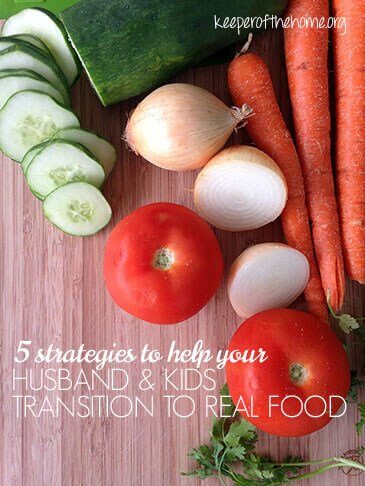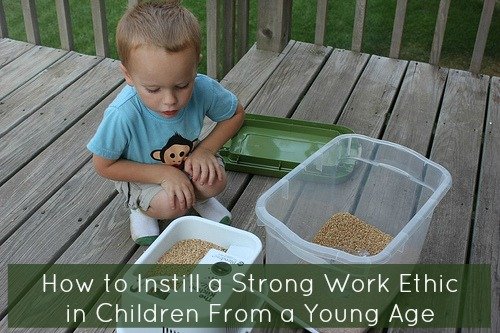5 Strategies to Help Your Husband and Kids Transition to Real Food

By Mandi, Contributing Writer
Are you working to ditch processed foods and put more real food on the table? This month we’re running a series called Real Food Made Simple: A Beginner’s Guide to Eating Better. Our goal is to answer the questions you might have and make the transition a whole lot easier!
I’ve always wanted to feed my family well, but in recent years, my definition of healthy has changed, and I’ve slowly but surely been moving my family from a standard American diet built around things like boxed macaroni and cheese and meals that come out of a can to a real food diet made from scratch with fresh food and basic ingredients.
I say slowly but surely because I’ve met some resistance along the way from my husband and girls, and I’ve decided that transitioning our diet gradually is more important than making our kitchen a battleground.
If you find yourself in the same place — ready to jump in with both feet but finding that your spouse or children are not quite as enthusiastic — here are a few lessons I’ve learned over the past few years.
1. Make healthy food fun.
This one works better on my children than it does my husband, but it’s been an important part of breaking them out of their pickyness.
First, when I say fun, I’m not talking about crazy character sandwiches and themed lunches. If you have time for that, more power to you…but I don’t. For us, fun is about the process of choosing, preparing and eating food. It means picking out a special “treat” in the produce section, sliding pieces of fruit and veggies on a kabob or helping Mom in the kitchen.
My favorite illustration of this happened a few years ago, shortly after we’d moved into our current home. Our oldest daughter was three-and-a-half and had always been a good eater, but she still refused most veggies. Then our new neighbors brought us an overflowing box of veggies from their garden — cherry tomatoes, regular tomatoes, green beans, etc. Our daughter’s eyes got wide with the realization that they’d grown them in their backyard, and she went to town eating the tiny tomatoes as quickly as I could wash them. To this day, she loves veggies.
Similarly, my girls will eat almost anything if we discover it while foraging. I’m by no means an expert forager, but I do know that the dandelion, plantain, lemon clover, onion grass and dewberries that grow in our yard are edible. These things don’t all taste that great when plucked fresh from the ground, but they’ll try them because it’s adventurous and exciting.

2. Try, try & try again.
I used to resent the advice that you have to present a new food up 20 times or more before giving up. That is a lot of wasted food! However, I’ve had to admit that repeated exposure really does work, although for most of my children, it doesn’t take 20 times for them to admit they like something. (And if I’m honest, I had to teach myself to like raw pepper sticks through this same method!)
Although it’s tempting to limit our menu to the things I know they’ll eat, I try to serve a few dishes each week that may not be as popular with everybody, and I was pleasantly surprised to realize a few weeks ago that almost all of the meals I served that week were met with enthusiasm from everyone, even though some of them had been repeatedly rejected in the past.
For us, the key to this method is to serve something they love alongside a new recipe. We serve them a small portion of each dish (about 3-5 bites of each), and they must try everything on their plate.
They don’t have to eat everything…unless they want more of the dish they like, in which case they have to clear their plates first. This method is surprisingly effective at getting them to eat those few bites without argument or fight, and I’m counting on repeated exposure to work from there!
3. Don’t expect an overnight change.
I’m an all-or-nothing kind of girl, and often that lands me on the “nothing” end of the spectrum because I give up if I can’t do something perfectly from the start. Throughout this process, though, I’ve had to admit that making incremental changes toward a real food diet is better than just giving up altogether, which means that box of mac and cheese — one of our favorites — hung around for quite a while (although we now have a homemade recipe that we all love!).
Similarly, we use white whole wheat flour much more often than whole wheat flour because my family hasn’t quite accepted the texture change.

4. Acknowledge That It’s Not a Moral Issue
If you’ve read my past posts here at Keeper of the Home, you know that I feel pretty strongly that other people’s food choices aren’t a moral issue and that our personal convictions should be our guiding light.
For my husband, the moral issues surrounding child slave labor in the production of coffee and chocolate is a no-brainer, and he agreed with my conviction that we should only buy fair-trade without a second thought.
When it comes to veggies, though, he doesn’t want any part of them, and while it’s tempting to declare myself his personal Holy Spirit and nag him about it, that’s really not my job. I continue to make and serve healthy food and encourage him to try it, but at the end of the day, if he wants to eat Pop-Tarts for breakfast every day (which he does…), that’s his prerogative.
5. Don’t Turn Food into a Battle
One thing I’ve always appreciated about Stephanie’s approach to real food and natural living is that she isn’t prone to extremes. She prioritizes relationships over food choices and enjoys an occasional unhealthy treat with her family. Not only does this make her lifestyle more appealing to someone like me who is still trying to learn and make changes, but it also means her kids are less likely to rebel or feel like they’re missing out!
Transitioning to a real food diet isn’t an easy process, and it’s even tougher when it’s being foisted upon you by someone else.

Although I want my family to eat better because I love them and want them to be healthy, I don’t want to be a dictator or a fight with them over every little choice. It’d be much easier if they’d instantly accept every change I make, but it’s not always that simple, and it’s important to me to make these changes in a way that takes their feelings and tastes into consideration.
Other posts in the series:
Real Food Made Simple: A Beginner’s Guide to Eating Better
Cutting Your Kitchen Prep Time in Half — Or More!
Confessions of a Formerly Picky Eater
The Grain Controversy: Should We Eat Them or Not?
Second Steps Towards Eating Real Foods: Switching Your Food Sources
Sweeteners: How They Affect You, Which Ones are Best, and How to Use Them
Simple Steps to Begin Cooking Homemade: Pantry Staples
Finding Real Food in the Grocery Store
20 Easy Real Food Switches and Substitutions {with Free Printable Chart}
First Steps to Eating for Fertility
Keeping Costs Down in a Real Food Kitchen
5 Ways to Get More Fruits & Veggies into your Diet
Food Is Not Cheap: 4 Steps to Budgeting in Real Food
Simple Steps to Begin Cooking Homemade: Baked Goods
Simple Roast Chicken (And Fabulous Side Dish Recipes!)
17 Homemade Spice Mixes {with Recipes & Why You Should Use Them!}
5 Ways Green Living and Real Food are Connected
Simple Steps to Begin Cooking Homemade: Soups, Sauces, and Simple Dinners
In what ways have you helped your husband and kids transition to real food?
*Editor’s Note: Mandi is being pretty humble about her real food transition here in this post! She has written a fabulous book chock full of homemade pantry staples called Easy.Homemade.! Check it out here.






Thank you for this post. I haven’t felt like I have been able to accomplish small changes towards whole foods because I become overwhelmed. This post resonates & helps me!
blessings,
The How to Guru
My kids aren’t necessarily picky eaters, but they aren’t as much into raw veggies as I would like them to be. And when I make new things they are always cautious. But, I find that if I give them a little bit (1-2 Tablespoons), and say they have to finish it before they can have anything else to eat, it works out pretty well. Granted, my kids are still very young (2 & 4), but I am trying to train them to eat healthy right from the beginning. I also have to say that we garden, and anything that my oldest helps plant and then watches grow and eventually picks, she will try and usually loves. Fresh peas from the garden, absolutely, frozen peas from the grocery store – she doesn’t understand why they aren’t fresh 🙂 My newest idea is to have a plate of raw veggies and hummus or white bean and garlic dip for the kids to snack on at will. It sits on the table, and anytime they are hungry they can go get a plate and snack away. I find that by the end of the day they have eaten most of the veggies, and that makes me happy!
I am loving this series of posts! Thanks for making it not judgmental, accessible, and encouraging. Too often I have read posts (not necessarily on this site) that list all the things you shouldn’t be eating, and if you are eating them you are a bad person. They throw so much information at you that one doesn’t even know where to begin, it seems overwhelming so why start, and yet then I am a bad person for having a bit of white sugar or throwing that frozen pizza in the oven b/c I am too tired to cook. And the husband’s point of view is valid as well. My husband looks at me like I’ve grown two heads when I start talking about some of the things I’ve read and when I say we should try them he does not even comment. It is a process and I will keep reading this series of posts as I feel more encouraged and positive than I ever have before on this topic. Thanks again.
LOVE this post! I am at that stage of meeting resistance from my kids and especially from my husband who does, also, in fact eat pop tarts for breakfast! This has encouraged me to keep offering real food dishes repeatedly hoping that one day they will decide they like it!
I think I need more recipes. We’re really new to this.
So glad it’s not just my husband who eats poptarts every morning for breakfast! LOL Not an easy thing to get rid of processed food, but I too don’t want to have battles in the kitchen so where I can replace whole foods I do usually at dinner time, but I still allow them their processed foods. I will not buy poptarts – but hubby always seems to get a few boxes each week. lol
I love this idea and I am making small changes regularly to offer more homemade meals. My biggest struggle is that one of my sons is a VERY picky eater and rarely, if ever, tries new foods. Any suggestions in this area or techniques you have used to get a picky eater to make some changes would be most helpful. Thank you
Hi, Mandy! This article is very encouraging to me and my husband. We’ve been working very hard at making healthy changes over the years, particularly this past year. Regarding #5, I would appreciate any advice on how not to turn food, especially dinner, into a battle. Dinner is a battle with our 6 year old every. single. night. We refuse to make something separate for her, but we do try to make meals that aren’t exotic or overly-seasoned since she has simple tastes at this point. It’s as though it’s gotten to be habitual that when we serve dinner, she won’t eat it out of principle. We have made it a rule that we won’t force her to eat, but that if she wants to eat, she needs to eat what she’s served. She usually picks at something she’s been served, but she’s not satisfied. Inevitably, there is bedtime drama because she’s grumpy and hungry. She gets to sleep late, then she’s tired and more grumpy. It’s a vicious cycle! And as her younger sister gets older, she is learning how to toy with similar behavior, despite actually being very open to a wide variety of foods and flavors.
I think for me it was choosing better ingredients to replace old ingredients and gradually not buying the packaged granola bars. If their only choice is the homemade kind, eventually they will eat it if they are hungry. My son is still not completely on board with this method (for some reason he thinks if it comes in labeled foil, it must taste better). It was the ingredients and the condiments that I started with. Who knew it would be so simple to make salad dressing, ketchup, cream of mushroom soup…?! But I really enjoy the homemade food better and I think the entire family feels better too!
Absolutely! My girls will now ask whether certain foods have HFCS and food dye without me prompting them, which has been great to see that they’re internalizing some of what I’m sharing with them!
Stephanie, that is where I am right now. I am switching things out and adding the healthy alternative. I avoid re-buying the processed version–though my husband is on a very different page than I am. I have started to make my own salad dressings and things as well.
You mentioned your son likes packaged things. As I am changing my kids over, I remove all cookies/granola bars and everything from the original package and send it in a container. They are still getting the “junk”, but they have lost the fancy packaging, so when I send homemade, it is very similar. 🙂
Two things…1. foraging is brilliant! Why haven’t I thought of that? 🙂 2. I found your comments about your husband amusing. We have a similar “conversation” around here about soft drinks. It ended about the same way yours and pop-tarts have. 🙂 What can we do??? 🙂
I love #4-don’t turn it into a moral issue. Yes, we try to eat healthier than most Americans, but there are times, when I pull out boxed mac & cheese or some other quick food {less than 2X/month}. Thankfully, my husband is very willing to try new foods.
Thank you for this post. I have been slowly making the transition and we just took another step forward in trying to eliminate extra food coloring from our diet. It is a struggle for our family too in convincing everyone to make the change, but each step is better.
I went Paleo on Jan. 1st, transitioned into it so have been dairy free for a week and wheat flour free for about a week too. Have lost 9 lbs. another 10 to go. My husband is into whole wheat bread and cottage cheese, and milk. He will stay with the dairy but is experimenting with no wheat at breakfast. I’m trying to find more he would eat besides omelets. Baked a banana bread with cashew meal today (forgot to put almond meal in it too) and it’s delicious so maybe he will try that tomorrow with his egg. My 9 yr old daughter is about 70%. We give her whole wheat pizza once a week and whole wheat cinnamon bread french toast once a week too. And if she is at a friends she will of course eat whatever they have……but I’m trying with her, just don’t want to her to have any major hangups going into middle school and puberty! I feel better, my body is not as sluggish and sore in the mornings. I have more energy, and am enjoying cooking and experimenting with new recipes. I was really in a funk about cooking for a while before.
Stephanie, thank you so much for the useful tips!
Thank you for the good tips. Has your husband tried these? http://us.naturespath.com/our-products?field_product_type_tid=11&field_special_diet_tid=All&field_superfood_ingredient_tid=All&field_new_value=All
Great suggestions – and so true. It took me at least a dozen times of introducing spinach, but now my son (age 6) is a huge fan – raw, sauteed, in smoothies, etc. I also trained MYSELF to like mushrooms. It took a while, but now I like most of them.
Thanks for this post. We are in the process of moving to real foods. It definitely takes baby steps! The two things that have helped the most with our children is growing our own fruit and veggies (that they helped to plant, weed, pick and cook) and reading food labels with them. We are still trying to use up some of our packaged foods, but after reading the labels, one of my daughters won’t have any part in eating them!
It’s funny that you mention pepper sticks. When I was a kid, I thought I was so grown up because I liked green bell peppers and radishes. Maybe I didn’t like them so much as the “grown-up” feeling, because as an adult I don’t like either of these veggies. Toss me some red or gold bell peppers and I’m all over those, though.
Thanks for the post! That pan of chocolately swirled stuff at the beginning…might that be a good whole foods recipe? If so, would you share it?
Hi Amy! It’s the brownie recipe from my Easy Homemade ebook (easyhomemade.net), but you could take any homemade brownie recipe and just substitute coconut sugar and melted butter for refined sugar and oil. Then I just swirled in some natural peanut butter, which is my very favorite way to make brownies!
Hope that helps!